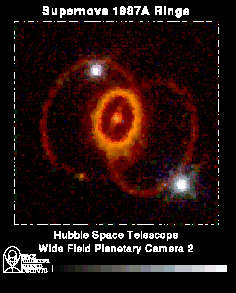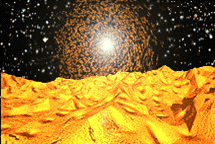ExploraTour: A Peek into the Lives of the Stars

Image from the Hubble Space Telescope, reproduced with permission from AURA/STScI.
Picture taken by the Hubble Space Telescope ten years after the supernova explosion.
The gas making up the rings is actually from the outer layers of the star that exploded. At the center of the rings, there is a neutron star about 20 km in diameter with a mass comparable to the mass of our sun.
The gas cloud around supernova 1987a is very complicated. That is because the star that became supernova 1987A was very close to another star. The gravity of the second star caused the gas from the exploded star to form interesting shapes.











